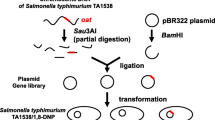Abstract.
N-Nitrosodiethylamine (NDEA) is carcinogenic in all investigated animal species at relatively low dosages. No threshold has been detected for these carcinogenic effects. The substance has been extensively investigated in various in vitro systems, revealing only weak mutagenicity at relatively high dosages. We reinvestigated NDEA in the Ames test with Salmonella typhimurium TA1535 to establish appropriate modifications of the standard Ames test protocol, to achieve a dose-dependent mutagenic response at a reasonably low dose range. Two main modifications were evaluated. Since the metabolism of dialkylnitrosamines is postulated to be mainly dependent on cytochrome P4502E1, a pyrazole-induced rat liver S9 was applied. The second modification involved a gastight preincubation, since metabolites of NDEA might evaporate from the incubation mixture. Cytochrome P4502E1 induction in Wistar rats was achieved by pyrazole treatment. For comparison, a rat liver S9-fraction produced by β-naphtoflavone/phenobarbital induction was used. N-Nitrosopyrrolidine served as positive control for pyrazole-induced S9-mix with TA1535. NDEA showed no mutagenic response under all test conditions in the presence of pyrazole-induced S9-mix. A strong mutagenic response, exceeding the base rate up to 15-fold at a dose range of 25–1000 µg/plate, was observed using β-naphtoflavone/phenobarbital-induced S9-mix, gastight preincubation and TA1535. In conclusion the Ames test with gastight preincubation can be useful for the testing of volatile compounds or substances leading to gaseous metabolites. The weak response of NDEA in the Ames test observed previously seems mainly to be due to the volatile character of its mutagenic metabolites. Our results do not support the hypothesis that cytochrome P4502E1 is a major toxifying enzyme for the formation of Ames-test-positive metabolites from NDEA.
Similar content being viewed by others
Author information
Authors and Affiliations
Additional information
Electronic Publication
Rights and permissions
About this article
Cite this article
Westphal, G., Bünger, J., Schulz, T. et al. Mutagenicity of N-nitrosodiethylamine in the Ames test with S. typhimurium TA1535 is due to volatile metabolites and is not dependent on cytochrome P4502E1 induction. Arch Toxicol 74, 638–641 (2000). https://doi.org/10.1007/s002040000175
Received:
Accepted:
Issue Date:
DOI: https://doi.org/10.1007/s002040000175




